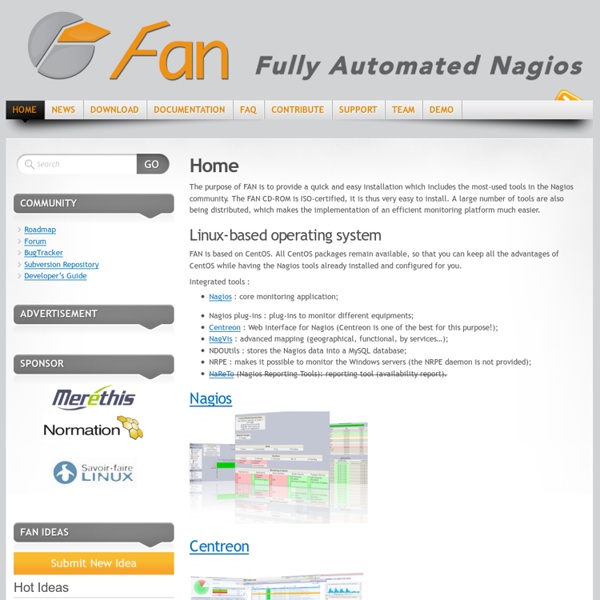



Nagios - The Industry Standard in IT Infrastructure Monitoring Nagios This document will breeze through installing and configuring everything necessary to get Nagios up and running. This will not touch in detail on the actual configuration directives Nagios uses. For that, documentation is readily available from the Nagios website, or available locally after Nagios is installed. I'll be explaining installation through RPMs and yum from Dag's repo (RPMforge), but source is available if you prefer to build your own. Again, documentation for this is readily available. System: CentOS 4.x/5x (Should work for any RHEL/Fedora flavor.) References: Packages: nagios-2.9-1.el4.rf nagios-devel-2.9-1.el4.rf nagios-plugins-nrpe-2.5.2-1.el4.rf nagios-plugins-1.4.8-2.el4.rf Other: Apache 2.0 General Upgrades A quick note about upgrading. Upgrading from 2.4 A quick note about upgrading. [me@mymachine ~] yum update nagios nagios-plugins nagios-devel nagios-plugins-nrpe Upgrading from 2.5 If you're upgrading from version 2.5 to 2.6, Dag's RPMs had a few quirks. Set up Apache Services
EyesOfNetwork » ACCUEIL EyesOfNetwork (“EON”) est la solution Open Source réunissant de manière pragmatique les processus ITIL et l’interface technologique permettant leur application. EyesOfNetwork Supervision est la première brique d’une gamme de produits bâtie autour de la gestion des évènements, de la disponibilité, des problèmes et de la capacité. La version 5 renforce ce positionnement en offrant : Une nouvelle interface web responsiveUne interface graphique de définition des processus métiersDes profils de rapports PDF (supervision + graphiques de performances)Un nouveau design de l’interface webLa génération automatique des graphiques à partir des données de performance de Nagios (Pnp4nagios)Un calcul du temps de prise en compte des événementsLa génération de popups à l’arrivée d’événements (RSS Feed)La simplification de la création des équipements et des servicesDes nouveaux plugins : Oracle, Network… Cette page est une publication sous licence GNU de documentation libre. L’équipe EyesOfNetwork
Open Monitoring Distribution - start FAN Shinken Ce dossier a été réalisé par : Le projet Shinken consiste en une refonte complète du cœur de Nagios en Python, lui apportant une nouvelle architecture plus souple et plus facile à maintenir que le daemon monolithique actuel. Se basant sur une vue Unix, l’architecture se compose de daemons simples qui coopèrent afin de proposer les mêmes fonctionnalités que Nagios, voir plus. Le nom est inspiré des sabres Shinken japonais qui sont les armes les plus coupantes des guerriers. Documentation Chapitre 1 - Shinken Chapitre 2 - Installation Chapitre 2 - Configuration Chapitre 3 - Expertise Chapitre 4 - Suppléments Nouvelle Documentation Cette documentation est basé sur un code couleur pour vous montrer rapidement le niveau de complexité des parties de la documentation. Débuter avec Shinken Approfondir votre connaissance de Shinken Perfectionnez vous avec Shinken Annexe
Monitor SQL Server (MSSQL) using Nagios - ben.goodacre.name/tech From ben.goodacre.name/tech Nagios is a free open-source monitoring software/platform. Service For a non-renamed instance the following can be used: define service{ use service hostgroup_name sql-servers service_description SQL Svc check_command check_nt! If the instance has been renamed the service will have a dollar-sign ("$") as part of it, for example an instance called "MAIN" will be called "MSSQL$MAIN". define service{ use service hostgroup_name sql-servers service_description SQL Svc PROD check_command check_nt! SQL port is open Default port for SQL is 1433 for non-named instances, adjust as required. define service{ use service hostgroup_name sql-servers-old service_description SQL Connectivity 1433 check_command check_tcp! If you have a named-instance SQL allocates a random port number upon installation. Connection check The following will allow Nagios to connect to the SQL server with a given username and password. Installing FreeTDS Test the plugin Load/health monitoring Connection time
Installation et configuration de Munin, le maître des graphes Munin est un logiciel de supervision permettant de centraliser la gestion des graphes de données RRDTools. Il permet en quelques commandes que nous allons détailler dans ce billet de générer des graphes complexes pour surveiller vous machines et les processus qui tournent dessus. Voici un exemple de graphe sur les statistiques remontées par un serveur utilisant Varnish: Munin est proposé sous la forme de deux packages complémentaires: munin et munin-node. Le premier (munin) est à installer sur votre serveur de supervision (appelé maître). Le second (munin-node) est à installer sur toutes les machines à superviser (appelées noeuds). La communication entre le serveur maître et les machines noeuds utilise, par défaut le protocole TCP/4949 (initialisation de la connexion TCP de la part du serveur maître). Pour la suite de ce billet (et sauf mention spécifique), je partirai sur le principe ou vous utilisez des machines sous Debian/Ubuntu. Installation de Munin sur le serveur maître
How to manage Windows services with PowerShell | Sysadmin's tricks Here I’ll show you how to manage Windows services using PowerShell. First we need get services we will be working with: Commands: Get-Service gives you list of all services on the host but if you need more settings, it’s better to use WMI Get-WmiObject Win32_Service command. Using filter Where-Object we’re able to sort services as we want: Next we can manage services using Set-Service command: <#Set service named Servicename to Disable startup mode and Stop it, if no any dependencies: #> Set-Service -name Servicename -StartupType Disabled -Status Stopped # If service has dependencies, use following command to stop service: Stop-Service -Name Servicename -Force #Set service named Spooler to Auto startup mode and start it: Set-Service -name spooler -StartupType Automatic -Status Running Using all info above we are able manage services on Windows computers. Example 1: Set list of services to Disabled startup mode and Stop them: Example2: Set list of services to Auto startup mode and Start them: